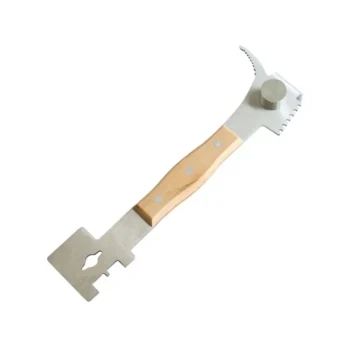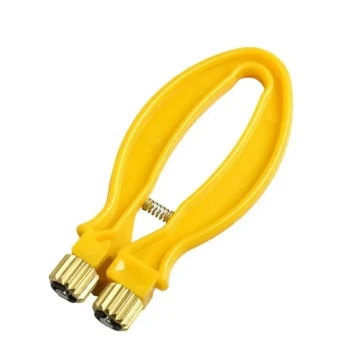To help keep your beehives cool naturally, you should focus on three primary strategies that augment the colony's own abilities. These include strategic hive placement to receive morning sun and afternoon shade, ensuring proper ventilation through the hive body, and providing a consistent and safe water source nearby for evaporative cooling. These methods work with the bees' natural instincts, enhancing their efforts rather than replacing them.
Your role is not to actively cool the hive yourself, but to create an environment where the bees can do so efficiently. By optimizing location, airflow, and water access, you empower the colony to manage its own temperature, preserving its energy for foraging and brood-rearing.
Mastering Hive Placement for Thermal Control
The location of your hive is the single most important factor in passive temperature regulation. A well-placed hive requires significantly less intervention.
The Power of Morning Sun, Afternoon Shade
The ideal location for a hive is one that receives direct sunlight in the early morning but is shaded during the hottest part of the afternoon.
Morning sun encourages the bees to become active and begin foraging earlier in the day. Afternoon shade provides critical relief, drastically reducing the thermal load on the hive and the energy the bees must expend to cool it.
Leveraging Natural Features
Position your hive to take advantage of the landscape. A location on the east side of a tree line, a building, or a dense hedge is often perfect.
This setup provides a natural barrier against the intense late-afternoon sun while still allowing for good air circulation.
The Importance of Ground Clearance
Elevating your hive off the ground on a hive stand is crucial. This simple step serves two purposes for cooling.
First, it prevents dampness from the ground from seeping into the wood. Second, and more importantly, it allows for air to circulate underneath the hive, helping to dissipate heat.
Optimizing Ventilation: How a Hive Breathes
A honey bee colony is a master of thermoregulation. Your goal is to ensure their efforts are not impeded by a poorly ventilated hive design.
Understanding the Colony's Natural Cooling
On hot days, you will see bees performing two key cooling behaviors. They may cluster on the outside of the hive in a "beard" to reduce internal body heat, and you will see worker bees at the entrance fanning their wings.
This fanning is a coordinated effort to draw hot, stale air out of the hive and pull cooler, fresh air in.
Creating a "Chimney Effect"
Proper ventilation creates a natural convection current. Using a screened inner cover or creating a small upper entrance allows hot, humid air to rise and escape from the top of the hive.
This "chimney effect" works in tandem with the bees fanning at the main entrance, establishing a continuous and efficient cycle of air exchange.
Using Screened Bottom Boards
A screened bottom board is one of the most effective tools for ventilation. It replaces the solid wood bottom of the hive with a sturdy wire mesh.
This allows for constant, gentle airflow from below, which helps to remove excess heat and moisture without creating a draft that would chill the brood.
The Critical Role of Water in Evaporative Cooling
Water is the honey bee's air conditioning fluid. Without a reliable source, their primary method for combating extreme heat is unavailable.
How Bees "Air Condition" the Hive
Forager bees will collect water and bring it back to the hive. Inside, house bees will spread thin layers of this water on the surface of the comb and then fan their wings over it.
As the water evaporates, it draws a significant amount of heat out of the hive, lowering the internal temperature just like a swamp cooler.
Designing a Safe and Reliable Water Source
Honey bees can drown easily. A simple bowl of water is a death trap.
Create a bee-safe waterer by filling a shallow dish or birdbath with marbles, stones, or corks. This gives the bees a safe place to land and drink without the risk of falling in.
Placement and Consistency
The water source should be close to the hive—ideally within 50 feet. This minimizes the energy bees must expend to collect it.
It's also vital that the source is consistent. Once bees find a reliable water source, they will continue to return to it. If it runs dry, they waste valuable time and energy searching for a new one.
Understanding the Trade-offs
While these natural methods are highly effective, they require thoughtful implementation to avoid unintended consequences.
Over-Ventilation in Cooler Climates
A screened bottom board that provides excellent ventilation in the summer can be a liability in the winter. Too much airflow can make it difficult for the cluster to stay warm.
Most screened bottom boards come with a removable insert (often called a varroa board) that can be slid in to close off the bottom for winter.
Full Shade Is Not a Solution
While afternoon shade is beneficial, placing a hive in full, dense shade all day is detrimental.
A perpetually shaded hive can become damp, promoting mold and disease. It also results in a less active, less productive colony, as the bees are slower to start their day.
Unsafe Water Sources and Pests
An open, stagnant water source can attract mosquitos and may become a vector for hive diseases if not kept clean.
Ensure your water source is refreshed regularly. A small fountain or a slow-drip system can help keep the water fresh and more attractive to the bees.
Making the Right Choice for Your Goal
Apply these principles based on your specific climate and beekeeping goals.
- If your primary focus is surviving extreme heat waves: Prioritize a reliable, close water source and afternoon shade, as these directly support the bees' most effective cooling mechanisms.
- If your primary focus is year-round hive health in a moderate climate: Use a screened bottom board with a removable insert to easily adjust ventilation between the heat of summer and the cold of winter.
- If your primary focus is simplicity and low intervention: The single most impactful choice is initial hive placement; positioning the hive for morning sun and afternoon shade solves many temperature issues before they start.
By understanding and supporting their natural strategies, you become a more effective partner in your colony's success.
Summary Table:
| Natural Cooling Strategy | Key Action | Primary Benefit |
|---|---|---|
| Strategic Hive Placement | Position for morning sun, afternoon shade | Reduces thermal load, saves bee energy |
| Optimized Ventilation | Use screened bottom boards & upper entrances | Creates chimney effect for heat escape |
| Reliable Water Source | Provide shallow, bee-safe waterer nearby | Enables evaporative cooling (bee AC) |
Keep your commercial apiary thriving in the heat. HONESTBEE supplies durable, well-ventilated hive equipment and essential supplies that support natural colony thermoregulation. Our wholesale-focused operations ensure you get the reliable gear you need to empower your bees' cooling instincts. Let's discuss your hive management needs — contact our expert team today!
Visual Guide

Related Products
- Long Langstroth Style Horizontal Top Bar Hive for Wholesale
- Inner Beehive Cover for Beekeeping Bee Hive Inner Cover
- Professional Drop-Style Hive Handles for Beekeeping
- Professional Grade Foldable Beehive Handles
- Heavy-Duty Stainless Steel Clip-On Frame Perch
People Also Ask
- How does the design of a top bar hive benefit beekeepers? Ergonomic & Natural Beekeeping for Hobbyists
- How are entrances designed in top bar hives? Master Beehive Layout for Maximum Honey
- How does the top bar hive help control varroa mites? A Natural Approach to Mite Management
- What is a top bar bee hive? A Natural, Low-Stress Beekeeping Solution
- What are the most popular types of hives besides the Langstroth? Top Bar & Horizontal Hives Explained



















